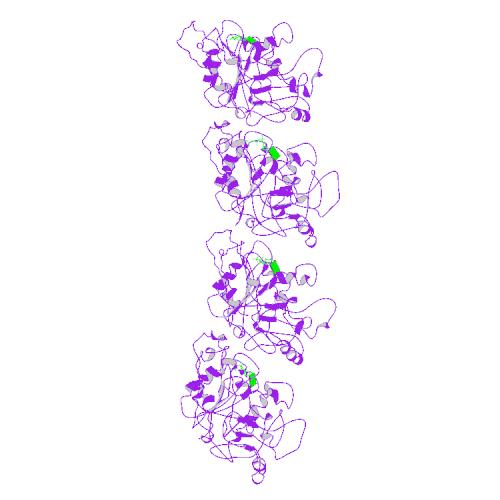Alpha-tubulin 3C
| Tubulin, alpha 3c | |||||||||||||
|---|---|---|---|---|---|---|---|---|---|---|---|---|---|
 PDB rendering based on 1ffx. | |||||||||||||
| |||||||||||||
| Identifiers | |||||||||||||
| Symbols | TUBA3C ; TUBA2; bA408E5.3 | ||||||||||||
| External IDs | Template:OMIM5 Template:MGI HomoloGene: 81744 | ||||||||||||
| |||||||||||||
| Orthologs | |||||||||||||
| Template:GNF Ortholog box | |||||||||||||
| Species | Human | Mouse | |||||||||||
| Entrez | n/a | n/a | |||||||||||
| Ensembl | n/a | n/a | |||||||||||
| UniProt | n/a | n/a | |||||||||||
| RefSeq (mRNA) | n/a | n/a | |||||||||||
| RefSeq (protein) | n/a | n/a | |||||||||||
| Location (UCSC) | n/a | n/a | |||||||||||
| PubMed search | n/a | n/a | |||||||||||
Tubulin, alpha 3c, also known as TUBA3C, is a human gene.[1]
Microtubules of the eukaryotic cytoskeleton perform essential and diverse functions and are composed of a heterodimer of alpha and beta tubulin. The genes encoding these microtubule constituents are part of the tubulin superfamily, which is composed of six distinct families. Genes from the alpha, beta and gamma tubulin families are found in all eukaryotes. The alpha and beta tubulins represent the major components of microtubules, while gamma tubulin plays a critical role in the nucleation of microtubule assembly. There are multiple alpha and beta tubulin genes and they are highly conserved among and between species. This gene is an alpha tubulin gene that encodes a protein 99% to the mouse testis-specific Tuba3 and Tuba7 gene products. This gene is located in the 13q11 region, which is associated with the genetic diseases Clouston hidrotic ectodermal dysplasia and Kabuki syndrome. Alternative splicing has been observed for this gene and two variants have been identified.[1]
References
Further reading
- Desai A, Mitchison TJ (1998). "Tubulin and FtsZ structures: functional and therapeutic implications". Bioessays. 20 (7): 523–7. doi:10.1002/(SICI)1521-1878(199807)20:7<523::AID-BIES1>3.0.CO;2-L. PMID 9722999.
- Oakley BR (2001). "An abundance of tubulins". Trends Cell Biol. 10 (12): 537–42. PMID 11121746.
- Dutcher SK (2001). "The tubulin fraternity: alpha to eta". Curr. Opin. Cell Biol. 13 (1): 49–54. PMID 11163133.
- Alexandrova N, Niklinski J, Bliskovsky V; et al. (1995). "The N-terminal domain of c-Myc associates with alpha-tubulin and microtubules in vivo and in vitro". Mol. Cell. Biol. 15 (9): 5188–95. PMID 7651436.
- Guilford P, Dodé C, Crozet F; et al. (1996). "A YAC contig and an EST map in the pericentromeric region of chromosome 13 surrounding the loci for neurosensory nonsyndromic deafness (DFNB1 and DFNA3) and limb-girdle muscular dystrophy type 2C (LGMD2C)". Genomics. 29 (1): 163–9. PMID 8530067.
- Marie-Cardine A, Kirchgessner H, Eckerskorn C; et al. (1996). "Human T lymphocyte activation induces tyrosine phosphorylation of alpha-tubulin and its association with the SH2 domain of the p59fyn protein tyrosine kinase". Eur. J. Immunol. 25 (12): 3290–7. PMID 8566014.
- Crépieux P, Kwon H, Leclerc N; et al. (1997). "I kappaB alpha physically interacts with a cytoskeleton-associated protein through its signal response domain". Mol. Cell. Biol. 17 (12): 7375–85. PMID 9372968.
- Dodé C, Weil D, Levilliers J; et al. (1998). "Sequence characterization of a newly identified human alpha-tubulin gene (TUBA2)". Genomics. 47 (1): 125–30. PMID 9465305.
- Kibar Z, Lafrenière RG, Chakravarti A; et al. (1999). "A radiation hybrid map of 48 loci including the clouston hidrotic ectodermal dysplasia locus in the pericentromeric region of chromosome 13q". Genomics. 56 (1): 127–30. doi:10.1006/geno.1998.5698. PMID 10036193.
- Herreros L, Rodríguez-Fernandez JL, Brown MC; et al. (2000). "Paxillin localizes to the lymphocyte microtubule organizing center and associates with the microtubule cytoskeleton". J. Biol. Chem. 275 (34): 26436–40. doi:10.1074/jbc.M003970200. PMID 10840040.
- Watts NR, Sackett DL, Ward RD; et al. (2000). "HIV-1 rev depolymerizes microtubules to form stable bilayered rings". J. Cell Biol. 150 (2): 349–60. PMID 10908577.
- Takeoka A, Shimizu M, Horio T (2001). "Identification of an alpha-tubulin mutant of fission yeast from gamma-tubulin-interacting protein screening: genetic evidence for alpha-/gamma-tubulin interaction". J. Cell. Sci. 113 Pt 24: 4557–62. PMID 11082048.
- Germani A, Bruzzoni-Giovanelli H, Fellous A; et al. (2001). "SIAH-1 interacts with alpha-tubulin and degrades the kinesin Kid by the proteasome pathway during mitosis". Oncogene. 19 (52): 5997–6006. doi:10.1038/sj.onc.1204002. PMID 11146551.
- Kourmouli N, Dialynas G, Petraki C; et al. (2001). "Binding of heterochromatin protein 1 to the nuclear envelope is regulated by a soluble form of tubulin". J. Biol. Chem. 276 (16): 13007–14. doi:10.1074/jbc.M007135200. PMID 11278332.
- Rommelaere H, De Neve M, Neirynck K; et al. (2001). "Prefoldin recognition motifs in the nonhomologous proteins of the actin and tubulin families". J. Biol. Chem. 276 (44): 41023–8. doi:10.1074/jbc.M106591200. PMID 11535601.
- Klein C, Kramer EM, Cardine AM; et al. (2002). "Process outgrowth of oligodendrocytes is promoted by interaction of fyn kinase with the cytoskeletal protein tau". J. Neurosci. 22 (3): 698–707. PMID 11826099.
- Saugstad JA, Yang S, Pohl J; et al. (2002). "Interaction between metabotropic glutamate receptor 7 and alpha tubulin". J. Neurochem. 80 (6): 980–8. PMID 11953448.